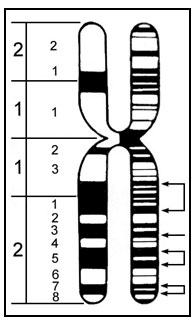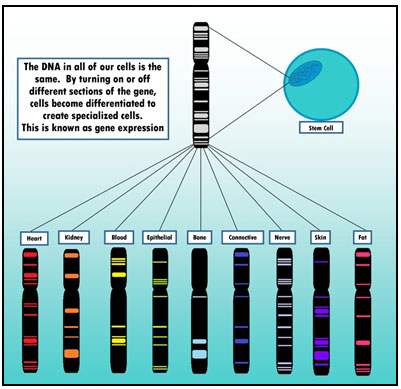

Dexoyribonucleic Acid, or DNA, is the molecule that controls the way cells function. It also holds the key to determine what type of specialized cells will be made. Stem cells are cells that have the ability to become any type of specialized cell in the body. After an egg cell and sperm cell unite to begin forming a new organism, all of the DNA in each cell of that organism will be virtually identical. If every part of the DNA in each cell is the same, then how does it end up with different types of cells? Let’s look more closely at the DNA to find out.

DNA is wound tightly into chromosomes. There are different regions of the chromosome code for every different function and cell type. Not all sections of a chromosome are turned on, or expressed, at the same time. Only the regions that are needed to perform a specific function are expressed in each cell. These regions are often depicted as bands or stripes on a drawing of a chromosome. These bands are called genes, and whether or not a gene is expressed determines what type of cell it will become. For example, genes that are expressed, or turned on, in a nerve cell are different from the genes that are expressed in a muscle cell. Both cells have the same DNA but expressing specific genes determines what type of cell it will become. This is known as gene expression.
Ribonucleic Acid, or RNA, is involved in making proteins that the cell needs to function. Since RNA translates and transcribes the DNA code, it can also influence cell differentiation.
![]() Now it’s your turn to see what happens as genes are expressed. Below is a picture of a chromosome showing a banding pattern. Use the key to express genes to determine what type of cell will be made.
Now it’s your turn to see what happens as genes are expressed. Below is a picture of a chromosome showing a banding pattern. Use the key to express genes to determine what type of cell will be made.
Sources for images used in this section, as they appear, from top to bottom: